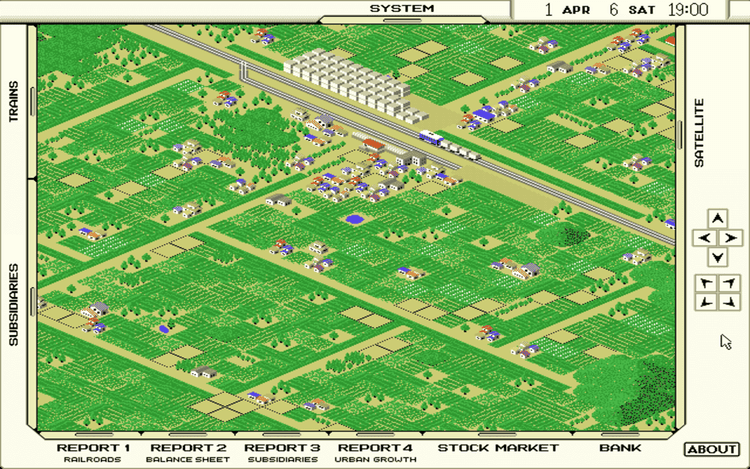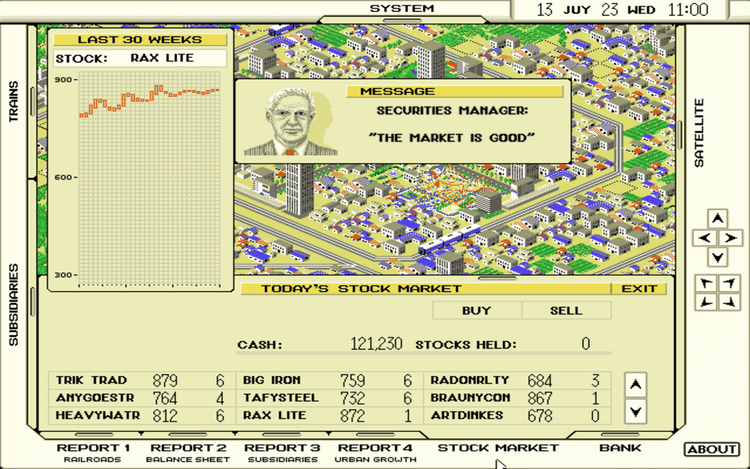
A-Train is a visionary railway management game crafted by Japanese studio Artdink and introduced worldwide by Maxis. In this engrossing simulation you lay track, schedule trains, and shape expanding skylines while balancing cash flow and investor confidence. Comparable to the civic creativity of SimCity and the network nuance of Transport Tycoon, the game rewards foresight, patience, and a keen eye for profitable routes. Whether you relish strategic planning, the thrill of watching a metropolis awaken, or simply want to play a classic tycoon game online, A-Train delivers an endlessly replayable experience that transcends hardware generations.
First released in the early 1990s, A-Train arrived when strategy games were still testing the boundaries of scale and complexity. Artdink’s design placed the player at the helm of a fledgling rail company, yet the scope quickly widens beyond locomotives. Each stretch of track lays the groundwork for neighborhoods, factories, and skyscrapers that blossom in real time, tying regional growth to your corporate success. The absence of scripted story beats means the narrative emerges organically: a once-quiet valley becomes a thriving junction, suburban sprawl envelops old depots, and your board of directors shifts from cautious optimism to confident expansion—all because you chose to run an early-morning commuter express.
A-Train is as much a lesson in macroeconomics as it is a transport game. Ticket revenue funds further construction, property values rise near efficient hubs, and seasonal cycles alter demand for passenger and freight services. Price signals are subtle; investors react to long-term profitability rather than short spikes, echoing real-world market behavior. Weather patterns change scenery and influence operating costs, while multiple train types—diesel, electric, even futuristic high-speed designs—encourage experimentation with timetables and line capacity. The simulation never feels static; instead, it hums like a living city, rewarding players who read its rhythms and adjust strategy accordingly.
Thanks to modern emulation, you can play A-Train online free of charge, directly in a browser, and even on mobile devices without restrictions. The original mechanics remain intact: intuitive cursor-driven rail placement, a top-down view that rotates across four perspectives, and a zoom feature for granular control. Performance scales effortlessly, letting seasoned tycoons test new theories or newcomers discover why this classic game sparked decades of sandbox design. No downloads, patches, or special accounts are required—just launch, play, and watch your miniature world grow at your own pace.
Many simulations struggle to remain engaging once their core systems are deciphered, yet A-Train’s layered economy still surprises. Perhaps your freight line props up remote factories only to find commuter demand outstrips supply, prompting a redesign of junctions and the addition of dedicated passenger expresses. Or maybe a coastal tourism boom invites investment in scenic routes and evening excursions. Every decision resonates through an interconnected web of supply chains, real-estate speculation, and municipal budgets, ensuring that successive playthroughs diverge in fascinating ways. The open-ended structure fosters creativity: some players pursue aesthetic perfection with symmetrical track art, while others chase aggressive market domination by monopolizing suburban corridors.
Three decades on, A-Train remains a masterclass in emergent storytelling and systemic design. Its minimal interface—simple menus, a compact financial ledger, and context-sensitive icons—keeps the focus on big-picture thinking, yet still offers enough granularity for micromanagers to tweak departure intervals down to the minute. Standard keyboard arrows move the viewport, function keys toggle informational overlays, and the space bar pauses the action for relaxed planning. Whether you savor slow simulation or rapid corporate conquest, the game’s blend of creative freedom and disciplined budgeting never loses its charm.
All used codes are publicly available, and the game belongs to its original authors.
Share game
Share game








Share game